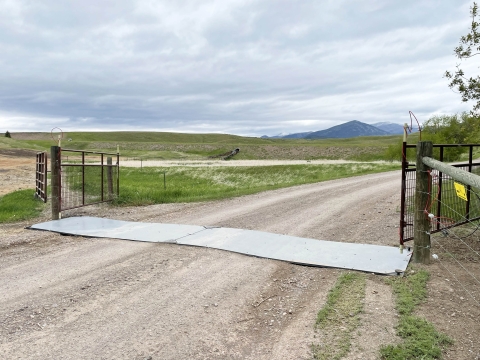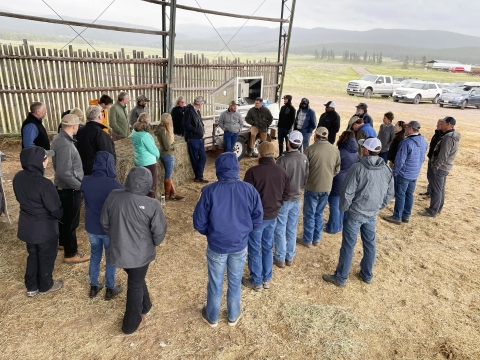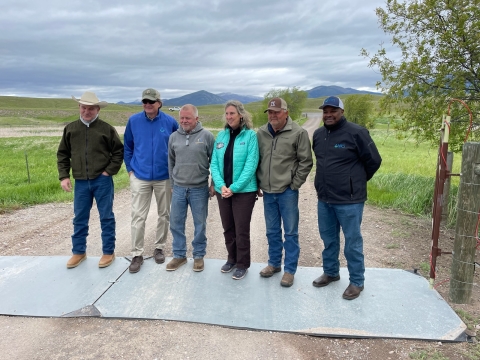Wayne Slaght has spent more than 25 years learning to coexist with grizzly bears and wolves on his Montana ranch near Ovando. In those years, he has learned an important lesson that serves as his guiding principle.
“If there’s no beef animals to eat, then they don’t learn to eat beef,” Slaght said. “They can eat deer and elk and whatever else they are supposed to.”
Protecting his cows requires constant vigilance, but Slaght has worked — with the help of State and Federal government agencies and nonprofits such as the Blackfoot Challenge— to implement a variety of preventative measures on his ranch and keep predators from eating into his bottom line.
Slaght, other ranchers in the Blackfoot Valley and a variety of partners have worked for more than a decade to develop innovative community-based approaches to reduce conflict between predators, livestock and people.
Two of those partners, the U.S. Department of Agriculture (USDA) and the U.S. Fish and Wildlife Service (USFWS), boosted their support for local, voluntary solutions this year including new funding and technical support.
Life on the Ranch
Slaght manages a roughly 50,000-acre ranch in Ovando, Montana, where he and his family run a little more than 1,000 head of beef cattle at a time, not including their 200 replacement heifers. Life on the ranch is all Slaght has ever known. He moved there with his family when he was four years old and has managed it since he was 25.
Managing a ranch that size comes with the normal challenges of dealing with weather, equipment, fences and the day-to-day responsibilities of keeping more than 1,000 cows healthy. But since the late 90s, Slaght has faced another challenge particular to his area of the country — grizzly bears.
Although they rarely see them in person, Slaght said based on images caught on cameras throughout the ranch and other evidence of their presence, they estimate about 10 grizzly bears are routinely living on the ranch.
Their first encounter with grizzlies came in the late 90s when bears came onto the ranch and killed a couple of calves in an event known as a grizzly bear depredation. The bears also gained access to the ranch’s pit, where they had hauled the carcasses of animals that died from natural causes during calving season.
The twin encounters led Slaght to look for ways to keep both his animals and his workers safe, while learning to coexist with the bears.
“I know a lot of people think that the bears should learn to live with us, but if I want to be here on this ranch, which I do, I feel that I've got to learn to live with the bears,” Slaght said. “So, we're always on our guard and paying attention.”
Slaght’s story is not unique. He and dozens of other ranchers in the Blackfoot Valley, a watershed of 1.5 million acres, all face these challenges and are working together to pioneer new solutions that can help prevent conflicts in the first place.
Protecting the Ranch
Slaght began implementing a series of practices that have become commonplace in the Blackfoot Valley to keep the bears out of certain areas on the ranch and limit attractants in the first place. He has not been able to do it on his own though. Over the years, he has worked with many partners including Montana Fish, Wildlife & Parks, USDA’s Natural Resources Conservation Service (NRCS), USFWS, and others to implement the needed deterrents.
“Without these partners, we cannot do these projects because they just cost too much, and this is all on us,” Slaght said.
One of the most successful practices, Slaght said, has been consistent carcass pickup throughout the ranch.
He estimates that during calving season the ranch loses 2-6% of its calves from natural causes, which could potentially create attractants for grizzly bears and other wild predators, such as wolves and mountain lions. To remove the temptation, Slaght has instituted a program where a team collects carcasses throughout the ranch twice a week during the two-month calving season.
The carcasses are taken to a composting site operated by the Montana Department of Transportation. In all, more than 50 ranchers participate in this effort, making sure that more than 1.5 million acres of working lands in the watershed are mostly clear of carcasses. Staying one step ahead of bears by removing the carcasses has been a tremendous help, Slaght said, and plays a major role in the predators never developing a taste for beef.
They have also taken extensive efforts to keep the bears out of calving and headquarter areas with more than four miles of six-wire electric fencing around their 400-acre calving area and an additional five or six miles of three and five wire electric fencing around other parts of the ranch. The goal is not to use electric fencing around the entire ranch, excluding predators and other wildlife, but to protect the most vulnerable locations of the operation.
In recent years they’ve also installed drive-over electric mats in gate openings. The mats provide multiple benefits over manual gates, Slaght said, including convenience by keeping them from having to open and close gates numerous times a day to keep bears out of sensitive areas. They also provide peace of mind by ensuring entrances and exits are always protected and they never have to worry whether they forgot to close a gate and left an area exposed.
Slaght has also reduced deterrents by securing the ranch’s animal feed in metal cargo containers so the bears can’t access it. The final pieces of the puzzle when it comes to bear prevention are range riders who patrol grazing areas.
“Just that presence of them up there in the cattle looking for tracks, wolves and grizzly bears and mountain lions or whatever,” Slaght said of their benefit. “They can see if the cattle are nervous. They can see with their cameras and with the tracks if there’s predators in the cattle. That’s quite useful, I think.”
The combined efforts have paid major dividends and Slaght’s ranch has not had a bear depredation event since the two encounters in the late 90s. Overall, because of measures like this being implemented across the valley, conflict has been reduced in the Blackfoot from 77 grizzly bear/human conflicts in 2003 to an average of 10 to 12 conflicts per year, according to USFWS data.
Help from Partners
Slaght is quick to point out that the success is not just his own. The efforts have only been possible by partnering with numerous public agencies and private groups who are invested in keeping ranchers and their animals safe while simultaneously protecting endangered species such as grizzly bears.
Those efforts have expanded in recent years through the development of a Regional Conservation Partnership Program (RCPP) project between NRCS, the Heart of the Rockies Initiative, the Western Landowners Alliance and additional partners. The RCPP project will provide $17 million of public and private funds to ranchers in Montana, Colorado, and Oregon to implement non-lethal methods of reducing conflicts between predators and working lands.
The methods Slaght implemented are eligible for financial assistance through the RCPP along with additional practices such as turbo fladry, where colored flags are placed along fences to deter wolves. Additional funding for electric fencing and electrified drive-over mats is available to ranchers in Slaght’s region of Montana through NRCS’s Grizzly Conflict Mitigation Targeted Implementation Plan, which provides funding through the Environmental Quality Incentives Program (EQIP).
“I think a big part of what NRCS does for the agricultural community is supporting the sustainability of farmers and ranchers,” said Robert Bonnie, USDA’s Under Secretary for Farm Production and Conservation. “Our place is to help those folks stay on the ground doing what they do, because they’re the best stewards.”
Additionally, thanks to funding from an America the BeautifulChallenge grant, the USFWS, in collaboration with the National Fish and Wildlife Foundation, Montana Fish, Wildlife & Parks, Heart of the Rockies, and USDA, is working with agricultural producers, Tribes and communities to implement and expand the use of proven and locally designed non-lethal prevention practices that reduce predator conflict. These practices will help restore habitat connectivity for grizzly bears across 18 million acres between the Northern Continental Divide and Greater Yellowstone ecosystems.
“Ranchers, farmers and others who live and work on the lands carry forward generations of knowledge, dedication and experience in achieving conservation outcomes and managing habitat,” said U.S. Fish and Wildlife Service Director Martha Williams. “These grants will help provide the tools Montana landowners need for successful ranching operations, while also providing open space and good habitat for a variety of wildlife species.”
Witness Conservation in Action
Bonnie, Williams, NRCS Chief Terry Cosby and others traveled to Montana in early June, where they met with Slaght and other ranchers in the Blackfoot Valley. These agency leaders were able to learn more about the importance of the predator conflict mitigation efforts and see many of the practices in action.
Jim Stone, chair of the Blackfoot Challenge and owner-operator of Rolling Stone Ranch near Ovando, Montana, hosted the group on the family ranch.
“Ranchers across the West are faced with increasingly complex challenges,” Stone said. “Our ability to ‘neighbor up’ and coordinate with a host of partners, including USDA, Fish and Wildlife Service and the state of Montana is helping landowners put new tools on the ground to make agriculture more resilient. I am very grateful for this partnership-based approach and the investments in our working lands that these conservations can yield.”
Slaght and Stone, who met with NRCS, USFWS and other leaders during their visit, echoed the importance of partnerships to help with mitigation efforts as grizzly bear and wolf populations grow in the area saying it requires open doors and good neighbors working together to implement these practices.
“We need to work with everybody to make it work because they're here and if we want to live here, we're going to have to deal with it and I just think that's key,” Slaght said.
Producers and their conservation partners elsewhere in the West are increasingly adopting a similar approach. A second NRCS RCPP award made in November 2023 provides $6.5 million to support producers and add range riders in the Mexican Gray Wolf Recovery Zone of New Mexico and Arizona in partnership with USFWS.
More Information
If you are interested in implementing voluntary conservation practices on your land, contact your local NRCS office to learn more.
Check out more information on the USFWS’ grizzly bear conservation efforts and opportunities to collaborate on conservation efforts.








